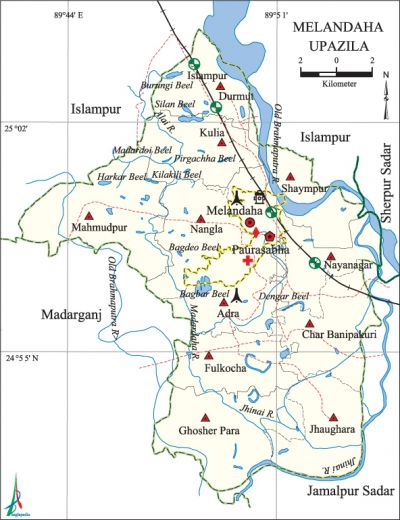Melandaha Upazila
Melandaha Upazila (jamalpur district) area 239.65 sq km, located in between 24°51' and 25°50' north latitudes and in between 89°42' and 89°53' east longitudes. It is bounded by islampur upazila on the north, jamalpur sadar and madarganj upazilas on the south, Jamalpur Sadar, sherpur sadar and Islampur upazilas on the east, Madarganj and Islampur upazilas on the west.
Population Total 292347; male 149708, female 142639; Muslim 288521, Hindu 3798 and others 28.
Water bodies Main rivers: Jhinai, old brahmaputra, Madardaha; Burungi, Silan, Pirgachha, Harkar, Kilakili, Bagbar and Bagdeo beels and Chatal Canal are notable.
Administration Melandaha Thana was formed on 21 May 1925 and it was turned into an upazila on 15 April in 1983.
| Upazila | ||||||||
| Municipality | Union | Mouza | Village | Population | Density (per sq km) | Literacy rate (%) | ||
| Urban | Rural | Urban | Rural | |||||
|
1 |
11 |
140 |
192 |
34139 |
258208 |
1220 |
33.7 |
25.7 |
| Municipality | ||||||||
|
Area (sq km) |
Ward |
Mahalla |
Population |
Density (per sq km) |
Literacy rate (%) | |||
|
12.96 |
9 |
27 |
28714 |
2215 |
35.2 | |||
| Upazila Town | ||||||||
|
Area (sq km) |
Mouza |
Population |
Density (per sq km) |
Literacy rate (%) | ||||
|
5.41 |
1 |
5425 |
1003 |
25.76 | ||||
| Union | ||||
| Name of union and GO code | Area (acre) | Population | Literacy rate (%) | |
| Male | Female | |||
|
Adra 17 |
5063 |
10331 |
9976 |
29.73 |
|
Kulia 66 |
5467 |
13004 |
12010 |
25.19 |
|
Ghosher Para 47 |
7570 |
16265 |
15540 |
28.11 |
|
Char Banipakuri 19 |
5838 |
15072 |
14645 |
27.95 |
|
Jhaugara 57 |
5277 |
12968 |
12344 |
22.27 |
|
Durmut 28 |
4112 |
10393 |
9867 |
26.19 |
|
Nayanagar 95 |
6451 |
9888 |
9365 |
23.53 |
|
Nangla 85 |
6082 |
11095 |
10732 |
22.67 |
|
Fulkocha 38 |
5085 |
11867 |
11499 |
35.46 |
|
Mahmudpur 76 |
8271 |
17391 |
16376 |
20.83 |
|
Shaympur 97 |
- |
6690 |
6315 |
16.88 |
Source Bangladesh Population Census 2001, Bangladesh Bureau of Statistics.

Archaeological heritage and relics Remnants of Neelkuthi at Basuria, remnants of kacharis (revenue offices) and dighis of Fulkocha and Mohiramkul zamindars.
History of the War of Liberation In the middle of the war of liberation the freedom fighters conducted guerrilla operation at Dewanganj of the upazila. During this time an encounter between the freedom fighters and the Pak army was held at a place near the Paila Bridge of the upazila.
Marks of the War of Liberation Mass grave 4 (Adipoita, Kayetpara, Konamalancha, Char Govindapur).
Religious institutions Mosque 519, temple 7.
Literacy rate and educational institutions Average literacy 26.6%; male 30.5%, female 22.5%. Educational institutions: college 7, technical college 3, secondary school 42, primary school 135, community school 8, kindergarten 12, NGO school 50, madrasa 53. Noted educational institutions: Melandaha Government Degree College (1972), Hajrabari Sirajul Haque Degree College (1976), Hajrabari High School (1926), Melandaha Umir Uddin Pilot Higher Secondary School (1937), Fulkocha Multilateral High School (1951), Melandaha Government Girls' High School (1963).
Newspapers and periodicals Weekly: Jhinai, Utshomukh, Shilpo-Shahitta Patro (defunct); monthly: Chonder Jhinai.
Cultural organisations Library 5, club 41, theatre group 2, cinema hall 5, women's organisation 2, playground 11.
Main sources of income Agriculture 70.50%, non-agricultural labourer 3.02%, industry 0.44%, commerce 10.33%, transport and communication 2.58%, service 4%, construction 1%, religious service 0.17%, rent and remittance 0.23% and others 7.73%.
Ownership of agricultural land Landowner 56.08%, landless 43.92%; agricultural landowner: urban 37.12% and rural 58.50%.
Main crops Paddy, jute, wheat, mustard, sugarcane, potato, chilli, ground nut, gram, black gram, tobacco, betel leaf, vegetables.
Extinct or nearly extinct crops Corn, sesame, kaun, linseed.
Main fruits Mango, jackfruit, coconut, banana, papaya, betel nut.
Fisheries, dairies and poultries Dairy 3, poultry 11, hatchery 6.
Communication facilities Pucca road 113' km, semi-pucca road 26 km, mud road 428 km; railway 12 km.
Extinct or nearly extinct traditional transport Palanquin, soari.
Cottage industries Blacksmith, nakshi kantha, bamboo work, cane work.
Hats, bazars and fairs Hats and bazars are 16, most noted of which are Melandaha Bazar, Hajrabari Bazar and Jhaugara Bazar.
Main exports Paddy, jute, potato, molasses, ground nut, chilli, gram.
Access to electricity All the wards and unions of the upazila are under rural electrification net-work. However 7.22% (urban 18.20% and rural 5.82%) of the dwelling households have access to electricity.
Sources of drinking water Tube-well 95.01%, tap 0.19%, pond 0.14% and others 4.57%.
Sanitation 13.87% (rural 13.98% and urban 11.27%) of dwelling households of the upazila use sanitary latrines and 59.10% (rural 59.20% and urban 58.27%) of dwelling households use non-sanitary latrines; 27.23% of households do not have latrine facilities.
Health centres Upazila health complex 1, satellite clinic 2, family planning centre 9, union health centre 8, community clinic 19, diagnostic centre 5.
Natural disasters The tornado of 1991 caused heavy damages to settlements and crops of Jhaugara union of the upazila.
NGO activities Operationally important NGOs are brac, asa, CARE. [Sayed Md Abdullah Al Mamun Chowdhury]
References Bangladesh Population Census 2001, Bangladesh Bureau of Statistics; Cultural survey report of Melandaha Upazila 2007.
